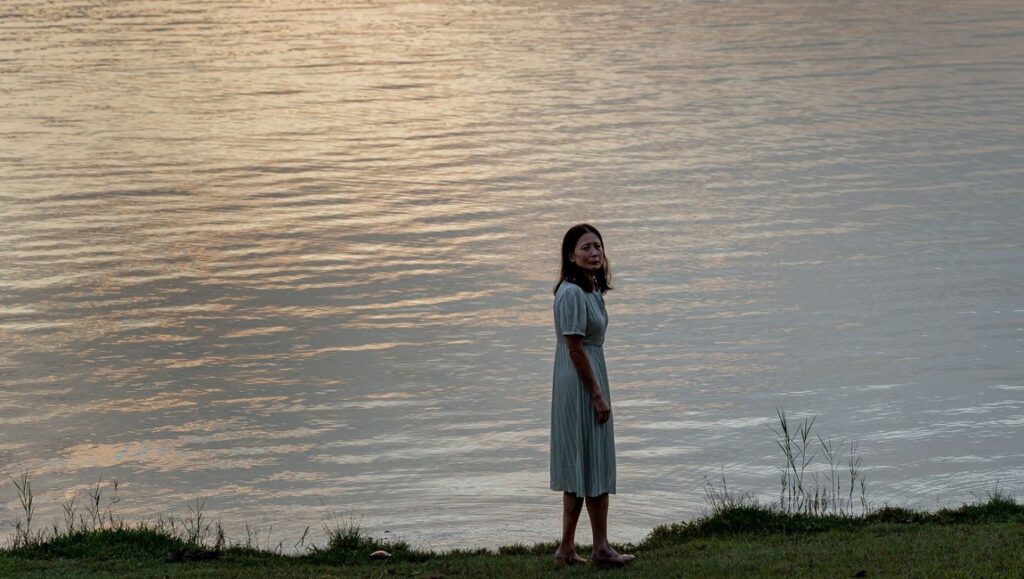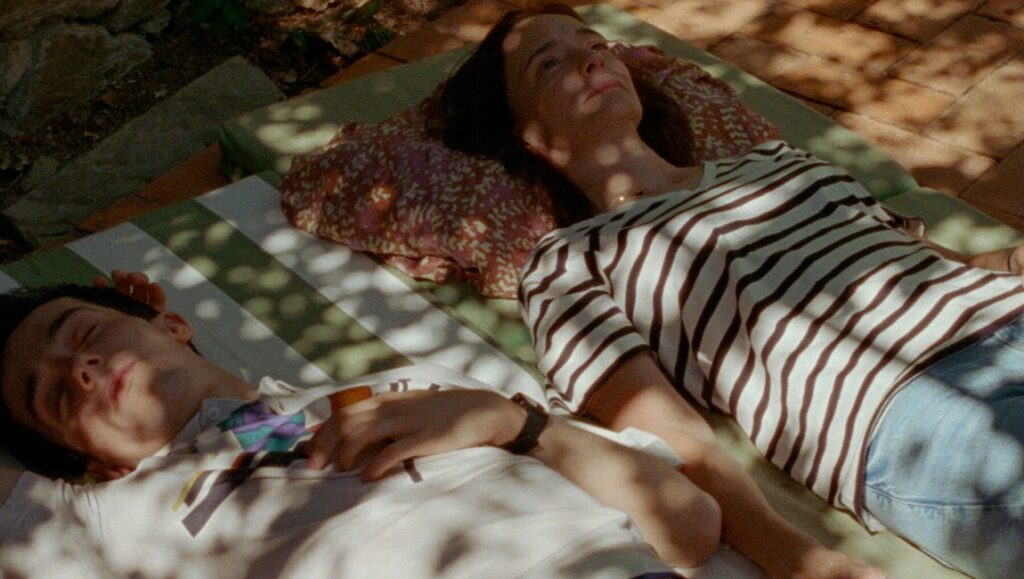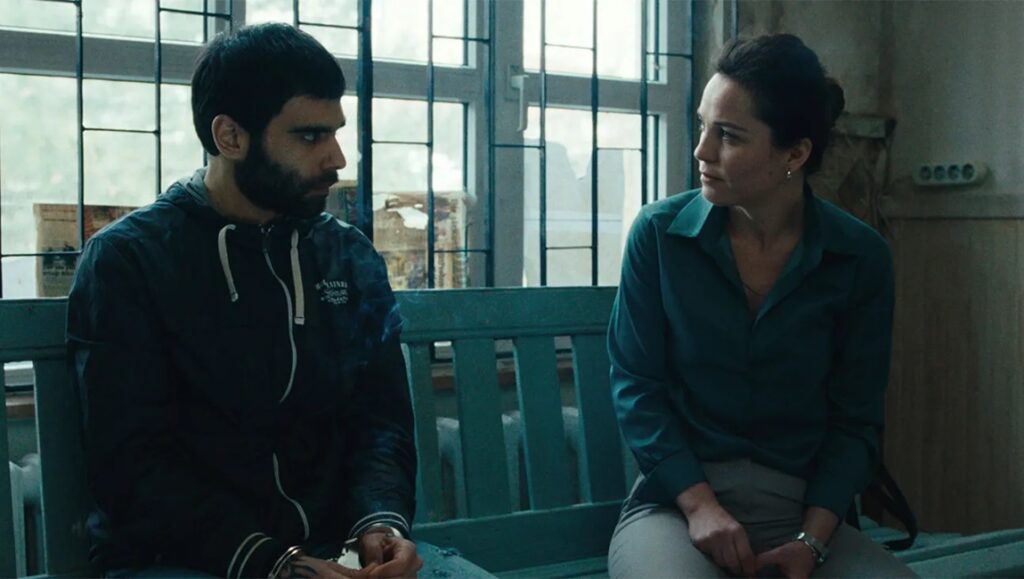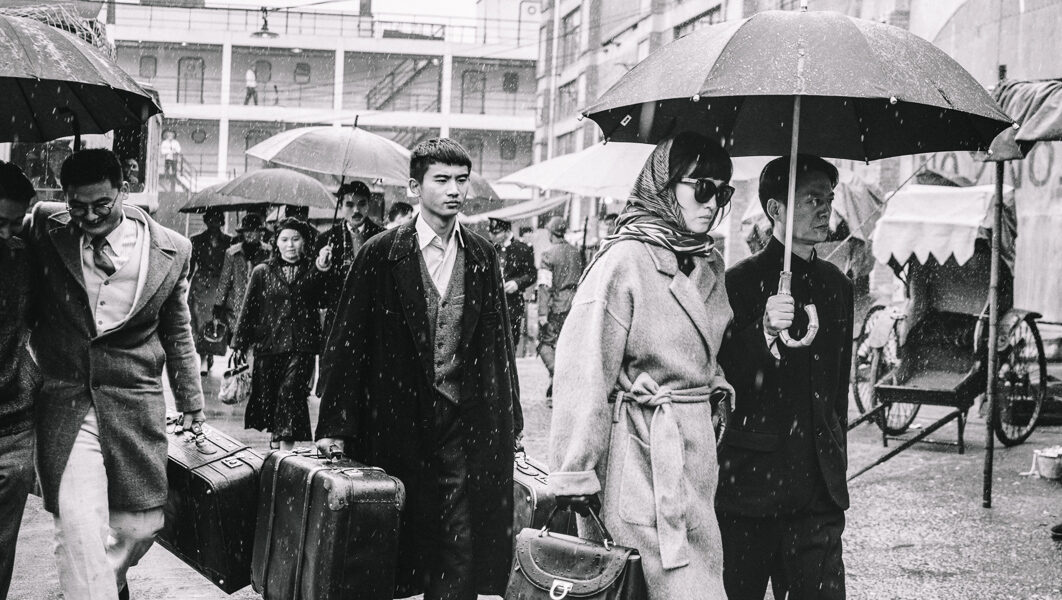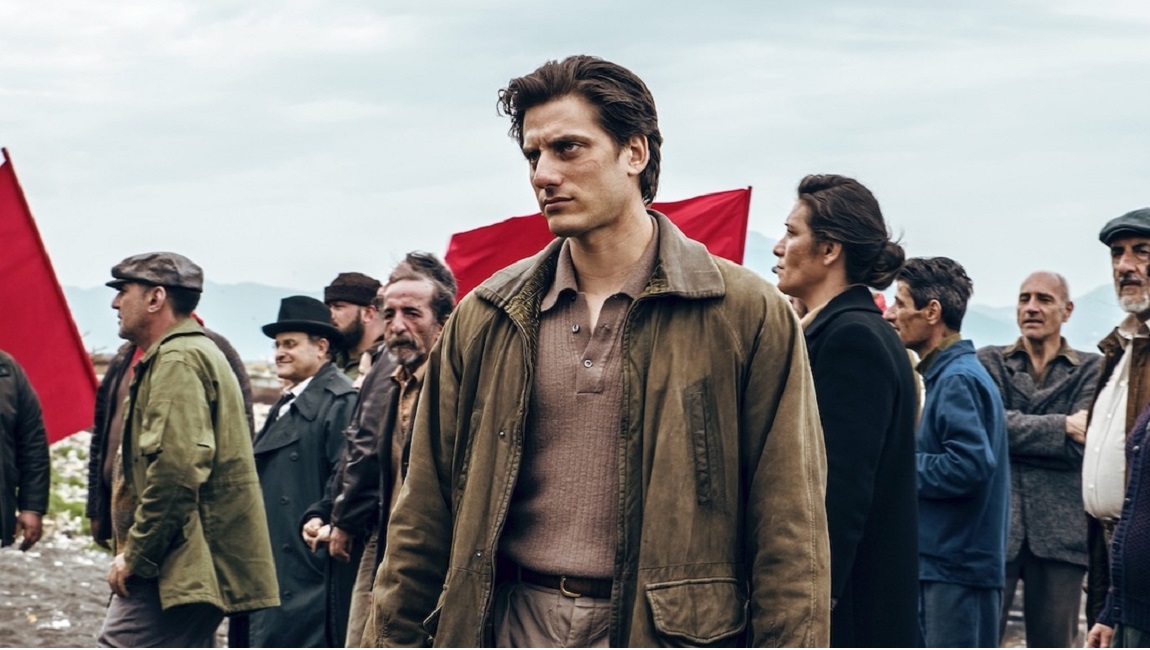Of Living Without Illusion
A long take is a relationship. It looks still and it contains and collides all its insides. Details from earlier — in the film, from the past — emerge in the stretch of the present space, less a sensation of tension than an accumulation. Connection becomes as likely as violence. Mostly, there is time to occupy a position and consider its impact. There is room to act or not. In Katharina Lüdin’s debut feature, Of Living Without Illusion, the long take becomes a standardized unit for thinking and rethinking the long relationship between two women, between the actor Merit (Jenny Schily) and the acted-on Eva (Anna Bolk). In composing her story almost strictly through such takes and by de-emphasizing filmic grammar usually deployed in stories about resolving relationships — camera movement, closeups, shot/reverse-shot — Lüdin has crafted a film at odds with the narrow and commodifiable language often attached to stories of our coupling. Critically and with a clear focus on her own patient tempo of occurrences and articulate blocking of bodies, Lüdin provides an alternative model for scrutinizing desire.
Of Living Without Illusion is the story of a breakup slowed by the gauze of suburban humidity, a fantasy of domestic partnership curdled into codependency. Merit rehearses a play with her ex-husband (Godehard Giese) and collaborates on a half-conscious, half-committed breakup with Eva, though none of these relationships are immediately obvious, as one effect of Lüdin and cinematographer Katharina Schelling’s insistence on stationary camera setups and long takes is the depriving of the spectator’s easy narrative assembly. Instead of framing characters in relation to the central breakup narrative, Of Living Without Illusion simply sets them to walk or recline through open cinematic space. The ensuing ensemble — Merit’s grown-up and growingly alienated son; his own romantic partner, a costume design intern at odds with her own self-investigation and tellingly the sole woman of color in the film; an unmoored younger daughter who may or may not be Merit and Eva’s child; a panoply of theater associates and artist-adjacents — must (usually literally) step around the schisming couple, their narrative meaning sometimes more a result of changing the film’s pH than its plot. From the perspective of pure craft, this tendency means that characters constantly come too close to the camera, only to walk beyond its limits. There is an attention here to the blocking of bodies that is increasingly welcome when considered against a popular cinema given to flighty weightlessness. Here is the great lesson from the theater: movement creates feeling. Distance is maintained, but so is presence. The frame holds the bodies, even if we wish it would move, or switch, or allow them to leave.
Merit and Eva are a couple in the last throes of their coupling, having reached the terminal stage of both admitting their own end and unwilling for each other to actually leave. Their presence together in frame takes on a gravitational force that pulls and pushes them together in spurts of intimacy — an intrusion of skin-kissed tussling in grass over a melty ice cream bar gives the spectator a pausing ache: this is the feeling at stake in this story — and shocks of violence. Late in the film, Eva confesses a moment of past traumatic physical violence inflicted by Merit that is both shocking in its direct consideration and unsurprising given the volatile romantic see-sawing of the central couple. There are lines that hold us together and there are lines that hold us: “She confines me, and I notice how it hurts her, but what can I do? She has become such a stranger.”
More than any recent European film, it’s tempting to lay Of Living Without Illusion against Ira Sachs’ similarly liberated Passages. How to describe either film, other than by saying, “this is how a breakup moves”? Where Passages’ sweaty, borderline campy outfitting of its breakup story is designed to provide as much pleasure as pain, Lüdin’s film exacts pain flecked with great and grave beauty: it is a joy to watch Schilly and Bolk sink their bodies into this story of rich collision, a pleasure to watch a sexy and strained film about queer women in their mid-50s, a privilege to watch such thoughtful 16mm grain. By avoiding formal and plot clichés that tip cinema toward resolution, Of Living Without Illusion indicates both the limits of filmic language to render the specific gravity of a breakup as well as the possibilities of showing life under that gravity in-frame. A feeling like “hope” can be pronounced as “despair” based on a change in the blocking. “It’s not about the backstory,” Merit says, “it’s just about this little moment that I witnessed. Just this moment. How someone simply is but cannot be.” These words are never conceived of as gospel, and they shouldn’t be assigned to the film’s authors as anything other than a provocative half-truth worth saying, sitting with, and then cutting away from. We have a relationship with a film. And then we watch another one. — FRANK FALISI
Dreaming & Dying
The rest of Yeo’s filmmaking comes across much like his approach to narrative — never really deficient, but maximally effective only intermittently. Some enticingly juvenile banter or a late burst of piscine violence may spark interest, but in general the premise is both too clichéd and too thin to sustain that interest… That’s not to say Dreaming & Dying isn’t a compelling debut, or a compelling film in and of itself, but it’s one in which a few of the seams are a bit awkwardly sewn, threatening to come apart. [Previously Published Full Review] — JESSE CATHERINE WEBBER
The Good Place
In his book Codes For North, filmmaker and film historian Stephen Broomer posits a history of experimental film as an “art that is a contest of difficult pleasures,” a particular kind of formal difficulty “that evolved in tandem with modernism.” The phrase comes to mind while grappling with Katharina Huber’s A Good Place, a sort of speculative sci-fi movie that eschews not only typical genre signposts, but many traditional narrative devices, too. It’s a fragmented, oblique work, one that forces an audience to sit within a certain degree of confusion. Perhaps unsurprisingly, early reviews have not been particularly kind, accusing Huber of art house pretensions and, more specifically, aping some of the formal strategies of Angela Schanelec specifically and The Berlin School in general. But these criticisms don’t account for the “difficult pleasure” of such a work — the confusion and unease is very much part of the point.
Transpiring in a kind of liminal, out-of-time narrative space, A Good Place follows the lives of friends Güte (Clara Schwinning) and Margarita (Céline De Gennaro). They live in a small village, and despite two isolated shots of television sets, there are no other signifiers indicating what year we might be in; there are no cars, no phones (cellular or otherwise), and no Internet. Characters spend much of their time listening to the radio, be it music or, more frequently, the chatter of news programs. Indeed, that constant chatter is almost omnipresent, creating a parallel, contrapuntal narrative that informs and expands upon the accompanying images. Güte seems to live with a revolving series of lovers, while Margarita is in a house with a large, extended family. Everyone seems to subsist entirely on a diet of poultry, and shots of chickens roaming the area, along with shots of coops, eggs, and discarded chicken parts become a sort of cryptic, free-floating symbolism for these people’s meaningless lives. There’s also a mysterious illness that has gripped the land, although it’s unclear if it’s localized or global. Meanwhile, the world prepares for the launch of a rocket ship that is set to explore the furthest reaches of the known solar system. A Good Place is structured as a series of 10 chapters, which count down backwards toward the rocket’s launch date. It’s all very strange, the oppressive mood of aimlessness and the constant threat of potential violence underlined by Huber’s propensity for static, off-kilter compositions and arhythmic editing patterns.
It’s difficult to synopsize an overarching plot here, although the film is packed full of incidents. One chapter details the women’s strange encounter with an older man who exchanges black-market goods and trinkets for sex; another chapter details Güte’s volatile relationship with an angry, emotionally disturbed boyfriend, although he is never mentioned again after his introduction. Various members of Margarita’s family fall ill, but Huber introduces certain narrative threads only to then immediately drop them. The women only mention in passing what has happened to other characters; someone shown to be bedridden in one sequence is later revealed to be dead and cremated. Huber’s insistence on major story beats happening offscreen is downright Bressonian, as is a pivotal sequence where Güte destroys the town’s main chicken coop — an action filmed from oblique angles and abstracted as a blur of motion accompanied by discordant jazz screeching on the soundtrack.
It’s this act of terrorism (or is it civil disobedience?) that forces Güte to flee into the woods and take up with the abusive Wolf (Jannik Mioducki), another angry young man who lives in the woods and frequently erupts into fits of sexual violence. Eventually, after an unknown amount of time has passed, Güte and Wolf return to the village, now largely depopulated thanks to people dying or fleeing. Güte, Margarita, and Wolf take over an abandoned house and seem to be living out some kind of apocalyptic fantasy life, lounging in bathtubs and helping themselves to whatever foodstuffs they can scavenge. It’s unclear why the women stay with Wolf, or why they seem so pleased that the village has collapsed. It’s the end of the world as they know it, but they seem fine. Huber seems interested in some kind of state-of-the-world critique here; it seems relevant that all the voices heard on the radio throughout the film are speaking English while the villagers are all German. The village might be out of place and dislodged from time, but a certain amount of globalization persists regardless. Ultimately, A Good Place seems to be about the ones left behind, an entropy of dissatisfaction at the world ending with a whimper instead of a bang. — DANIEL GORMAN
Explanation for Everything
If we give Reisz the benefit of the doubt, we could assume that the boiling down of all simmering class resentment to left-vs.-right politicking is itself the point, that these simplifications draw attention and sell newspapers, but ultimately obscure more than they illuminate. However, Explanation is not an equal opportunity satire… that’s not to suggest that Explanation for Everything is politically biased. It’s just rather half-assed, with Reisz taking the longest possible route to travel the shortest intellectual distance. [Previously Published Full Review] — MICHAEL SICINSKI
The Permanent Picture
There’s really nothing wrong with The Permanent Picture, the debut feature from Catalan director Laura Ferrés. It features two skillful lead performances, is exceedingly well shot, and spins a tale that, while not entirely plausible, succeeds in communicating intergenerational melancholy, the emotional distance between youthful impetuousness and late-life regret. This film suggests that Ferrés has drunk deep from her film school education, and that she is likely to produce distinctive cinema in the future.
Despite the faint praise, there really isn’t anything wrong with The Permanent Picture. It’s just that it’s immediately recognizable as a 2020s festival-circuit film, bearing nearly all the standard markers of that phenotype. Camera movement is limited, but Ferrés meticulously frames each shot to lend a sad geometry to its mundane environments. The actors almost all exude the hangdog, post-Buster Keaton stillness we observe in droll international comedies, particularly those of Aki Kaurismäki and Martín Rejtman. And the single performance least tamped down by that approach is the one which intrudes on the main character’s orderly world, inducing the small spasms of chaos that drive the film forward.
The Permanent Picture begins with a past-tense prologue in which a very young girl, Antonia (Saraida Llamas), has a baby. Incapable of handling the responsibility, she bolts, leaving the child to be raised by her grandmother, Milagros (Mila Collado). We then cut to nearly 50 years later. The child, Carmen (María Luengo), is living an uninspired life, working as a casting director for an ad agency. She is tasked with finding ordinary people to appear in political spots for an unnamed party running on the slogan of cambiar (“change”). In keeping with this bland mandate, Antonia is told to find subjects who are “authentic… but not too authentic.”
Outside a market she encounters Antonia (Rosario Ortega), a feisty, at times aggressive drifter who makes her own perfumes and hawks them in the street. After a scuffle, Antonia slowly becomes a presence in Carmen’s life, the friend and even, maybe, the mother she never had. Viewers are aware that Antonia is indeed Carmen’s long-lost mother, and so the muted drama of The Permanent Picture is predicated on whether, and when, Carmen and Antonia will make the discovery themselves. With her hard-bitten demeanor and impertinence toward bourgeois niceties, Antonia helps Carmen’s personality emerge, as both women try to figure out how the other one may fit into their life.
The Permanent Picture is pleasant. It exemplifies restraint, avoids sentimentality, and even elicits a chuckle or two. But it does seem to be the product of an artist who, like Carmen, is still trying to find her own voice. It’s a comfortable film, a familiar one. We typically discuss “comfort” when addressing more popular genres, like rom-coms or biopics. But today, “art film” is often just as formulaic. It’s easy to see why grant panels and festival programmers appreciated The Permanent Picture. It fits like an old shoe. If that’s what you want, here it is. — MICHAEL SICINSKI
Omen
Where Baloji’s film begins to falter is in its structure. The respective, sorcery-specific storylines of Koffi, Paco, Tshala, and Mujila are loosely woven, and the film straddles an awkward line between anthology film and multi-lead, Magnolia-esque odyssey, without ever firmly amounting to either. [Previously Published Full Review] — SARAH WILLIAMS
Foremost by Night
Music is present throughout the film (Cora is a piano teacher and Egoz a musician), as is a precision of movement, and in the film’s final sequence, Iriarte unites these features with a similarly meticulous pattern of cutting just as his three lead characters are united. Foremost by Night delivers on the strength of its artists’ resumes, but also exudes the vitality of an exciting new voice. [Previously Published Full Review] — JESSE CATHERINE WEBBER
The Day I Met You
The sophomore film from Brazilian director André Novais Oliveira is a charming cinematic miniature that observes the unfolding of an ordinary day that potentially evolves into something much more meaningful. While not completely avoiding the basic template of Richard Linklater’s Before films, The Day I Met You operates within a slightly broader frame, and this makes its incipient relationship that much more surprising, for characters and audience alike.
Zeca (Renato Novaes) is a large guy in his late twenties or early thirties. He works as a school librarian, a job he very much enjoys. But he’s been having trouble waking up in the morning, resulting in excessive tardiness and absenteeism. On the day in question, he actually has a chance to make it on time, but the bus from Belo Horizonte (where he lives) to Betim (where the school is) breaks down on the highway. We see Zeca grab a couple of empanadas while the next bus comes, almost misses the next bus, but catches it just in time.
Alas, it’s too little, too late, and Louisa (Grace Passô), one of his colleagues, breaks the news to him. He’s been fired. Feeling sorry for Zeca, Louisa offers him a ride home so he won’t have to deal with the bus again. As they start awkwardly chatting, they discover they have a number of things in common. They were two of only four people of color who worked at the school. And as they begin to open up to one another, they find that they are both facing similar challenges in life.
Novais Oliveira constructs The Day I Met You like a minimalist short story, combining a clear-eyed examination of the mundane world with unexpected focus on small, evocative details. We don’t learn a great deal about Zeca’s or Louisa’s pasts, but what we do see of the pair gives the sense that they are fully formed characters who encounter one another at a pivotal juncture in their lives. We get to share that experience, in all its confusion, humor, and hope. — MICHAEL SICINSKI
Hesitation Wound
Nacar builds a remarkable amount of tension in a very simple dramatic framework. What’s most effective about Hesitation Wound is also Nacar’s refusal to ever let this tension uncoil and the pressure subside… Ultimately, when storm clouds appear in the film’s closing moments, arriving over a landscape shot filled with ambiguity, it’s obvious how little it matters that we’ll never find any resolution — the end is coming, who cares how it gets here? [Previously Published Full Review] — JOSHUA BOGATIN
Shorts Program II
New Directors/New Films takes a certain amount of pride in the names they’ve launched, and it’s not unjustified: any festival that can boast Hou Hsiao-Hsien, Spike Lee, and Kelly Reichardt has done their job well. Viewers with an interest in the experimental side of the film world, however, might note that the list of their alumni is rather light on short-form works and avant-gardists. Even considering that more people viewing their website will know Wong Kar-wai than Simon Liu, it’s a testament to the conservative approach of their short film programming. Past installments of ND/NF have promoted the occasional experimental artist of note in their shorts programs, but there’s also an excessive fondness for narrative short films, a largely dead-end approach to conveying characterization that’s rarely ever succeeded and which is now largely utilized as a calling card for a subsequent feature. When combined with the fact that most directors (let alone new ones) either can’t or won’t use more radical formal approaches, it serves to expose the flip side of the coin in supporting new artists: some are just settled for, in the hopes that they’ll eventually make something better with the publicity.
Shorts Program II of the 2024 edition of ND/NF seems to be the more experimentally oriented of the two, although that’s all relative. Nobody in this grouping settled for just shooting a classical narrative project per se, and even if that only intermittently translates into all of the promise of a new director making a new film, the ones who attempted to venture further out and made actual experiments are nevertheless a step in the right direction of recognizing what could come next for the medium and programming accordingly. A paradox baked into this grouping is that the one title in the group that will screen on supposedly obsolete celluloid had the greatest deliverance of new ideas and pleasures in its form, while the film that tried the hardest to be current just tried hard. If one judges short film programs on their strongest contribution, then it’s a must-see, and one suspects that the festival knew it: they saved it for last. The overall collection, perhaps inevitably, has the hit-and-miss quality of any anthology work.
Juliana Zuluaga’s The Night of the Minotaur is constructed around black-and-white archival footage, with the director narrating the story of Luz Emilia García, the director’s grandmother, while also utilizing old stag films to make the claims that she was “the last minotaur” in the primordial lusts of her proto-pornography work. She leans into the sinister qualities of archival footage by playing with video dropouts, frame damage, and a score that lends a dark ambiance to musings such as her grandmother’s inability to bear a son and her grandfather’s unusually pale skin. Zuluaga has a good handle on how to keep this stylistically consistent without making it monotonous, in part because the old pornographic footage being so clearly of a certain vintage is legitimately startling: the strongest material features explicit references to Satanism, and bears some resemblance to certain segments of Pasolini’s Salo. However, said material comes from relatively well-known and decidedly un-Colombian sources, namely the 1928 French pornographic film Messe Noire, and this knowledge makes the effect more synthetic than primordial.
Lou Fauroux’s deeply tiresome The Porn Selector threatens to be the first entry in a project, “The Internet Collapse,” asking if there’s life after the Internet. Following a barrage of alarms and announcements that the World Wide Web is going down forever, a character begins meditating with the grammatically dubious proclamation, “I am alive despite the World Wide Web is going to die, I am capable to live without the Internet.” Once she declares that Internet shopping helps her solve all her problems (so much for being capable to live without the Internet?), we know we’re in Adam McKay territory. Some of the more notable features of this universe include a cryptocurrency called “Buttcoin” and a barrage of deliberately tacky digital effects that are surprisingly retro for something straining so hard for commentary on the current moment. Some of Fauroux’s choices are clearly meant to be uncanny or alienating (such as the aforementioned grammatical errors), but that’s about all the credit she’s due for this shrill calling card.
Cameron Worden’s Digital Devil Saga claims to have been designed for the stereoscopic qualities of a 35mm print, with archival print stock specified to ensure the images will remain permanent. It’s an initially curious claim for this carpet bomber of Internet imagery and Chicago rap, which takes the firmly digital individual frames that constitute GIFs, memes, and screenshots and jumbles them up. When they flash by at 24 frames per second, you can occasionally grab hold of a pattern if Worden lets you: screenshots require you to speed-read (one features Worden himself), visual recurrences form mandalas of kitsch, and the illusion of motion in a GIF remains identical, even as the individual frames of Elissa from Big Brother spitting out her water or the cheery gun-waving from Shady’s “Go In” music video get separated by various forms of clutter. You could have a field day playing this in slow motion if you memorized the lyrics of the Chicago rap songs that tie it all together (one song’s lyrics play off a sequence devoted to Mario Kart nicely). The approach isn’t new and isn’t meant to be: Tony Conrad’s classic The Flicker and its doctor’s warning make a cameo, Owen Land’s pissy humor manifested in a similar formal approach for the structuralist A Film of Their 1973 Spring Tour Commissioned by Christian World Liberation Front of Berkeley, California, and Cameron shares his last name with Fred Worden, whose film One settled for taking apart a single image. Land’s film, and his body of work as a whole, is perhaps the best guide for Digital Devil Saga’s approach: that of a joker who favored visuals that resembled the bland look of educational films in order to play his own kind of tricks. Worden latches onto a different kind of visual blandness by prying open the everyday qualities of the Internet and rendering our daily sensation of being barraged by screens into a time-based form: you have to put up with this every day, but is it so much more difficult when it’s concentrated into 11 sequential minutes of exaggeration? The contrast between this work’s visual-music qualities and the ugliness of the individual frame-notes makes it one of the more counterintuitive works built around the principles of sampling. It’s not the first work to take the approach of exaggerating contemporary kitsch rather than isolating moments of great beauty in its approach to pop culture detritus, but it might be the most perfectly executed dive into the sewage tank. — ANDREW REICHEL


